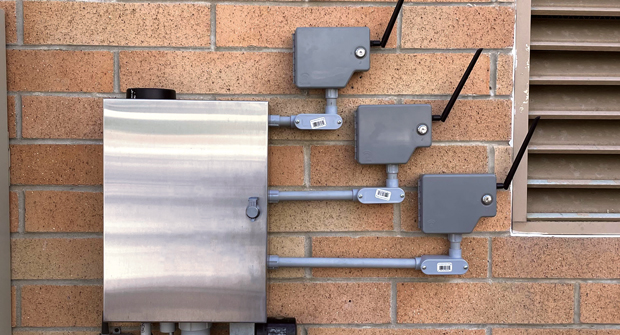Legacy irrigation systems are a headache for technicians and their clients. Aging sprayheads, leaky valves and especially old, wired controllers use water inefficiently, communicate poorly and are a costly, logistical nightmare to maintain and upgrade.
Innovations in wireless technology are more attractive solutions that can rejuvenate an irrigation system, improve efficiency and keep it in service longer.
Long-term fix
Seth Bangerter considers himself an irrigation system’s best friend because he can make any irrigation system wireless.
“It doesn’t matter what (brand of irrigation) controller you have, and it doesn’t matter how old, new, smart or dumb those controllers are, we get rid of the wire from the controller out to the valve,” says the president and co-founder of Thrive Smart Systems, maker of the Thrive EVO, a wireless controller solution for the residential, commercial and golf markets.
A wireless communication path optimizes an existing irrigation system, which increases water savings for the customer, albeit indirectly, Bangerter says. For example, a client has a bad wire or lost a valve somewhere in the system. An irrigation contractor has two options: retrench or divide the existing system with an additional controller.
“The problem is nobody really solved the problem,” Bangerter says. “Instead, these are Band-Aid solutions. One is really expensive, and dividing the system isn’t a (long-term) solution because the wire is prone to fail. Suddenly, two controllers become five, which becomes seven, which becomes nine … So, as valves get separated from their controller, they become orphaned, they become unmanageable and useless, and you are no longer water efficient.”
Wireless controllers take those orphaned valves and adopt them back into the existing irrigation system. It’s a plug-and-play solution that protects the original investment in the system rather than making a temporary fix, Bangerter says. As a result, the irrigation system is controllable from anywhere, it behaves as it’s designed to, and all the alerts are informative and accurate, he says.
“Make it wireless, and the system is complete,” he adds. “You just saved time and money with (a product) that takes less than 30 minutes (to install).”
Untapped potential

Wireless technology offers the irrigation industry a lot of potential to serve their clients better, whether commercial or residential, says Chris Klein, chief product officer and co-founder of Rachio, which offers smart irrigation controllers.
Recently, Rachio combined its wireless controller technology with a weather station via the cloud, allowing an irrigation system to process data and make real-time adjustments. This marriage represents the first integration with Rachio’s new hose and timer products.
“We’ve created the architecture where the weather station can communicate through the cloud with our valves, and we’ve built it in such a way that our valves can act as zones,” Klein says. “So, instead of just having to go device to device to control it, you can actually coordinate them together (to run sequentially).”
Suppose a contractor is adding zones to a property’s existing irrigation; those can be run like an above-ground system and maintain optimum water pressure, create schedules and integrate with other components, like weather stations.
“While you once needed a piece of hardware to coordinate zone one, zone two and zone three, now you let (a wireless controller) coordinate across devices, and those devices don’t need to know about each other,” he explains. “Then your central computer creates the schedules and sends down individual calendars that coordinate all the different devices, which allows you to add to that scale with modularity.”
Wireless innovations will allow opportunities to retrofit clients’ existing systems, which is a more cost-conscious option than a total overhaul.
Klein anticipates this technology will continue to improve, allowing pros to program and coordinate schedules across multiple devices based on more detailed data.
“The hardware and radios exist,” he says. “But being able to make them all work together will involve (innovations) in that software layer.”


